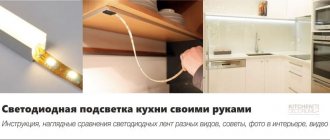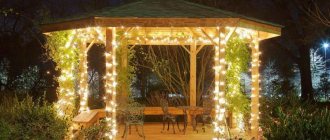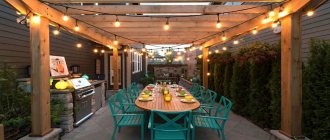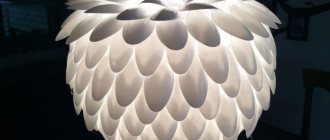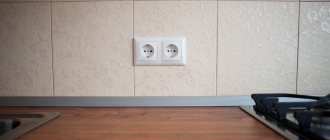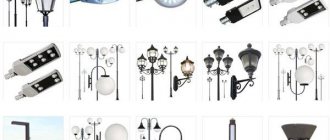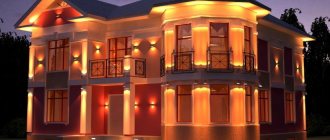Eating food takes a fairly long period of the day, and its preparation takes even longer, so comfortable conditions in both one and the other process are the norm of our time.
If previously housewives made do with one lamp or chandelier in the center of the room, the variety of lighting fixtures today makes it possible to provide not only uniform lighting in the kitchen, but also decorate the room through lighting effects and decorative elements. Modern methods of installing and planning artificial lighting provide a number of nuances that should be taken into account when making lighting and kitchen equipment.
Basic rules and requirements
Electricity in the kitchen poses a particular danger due to its close proximity to water, gas supply and heating systems. Therefore, when planning lighting in the kitchen, it is important to follow a number of rules that will make work and pastime not only comfortable, but also safe.
Next, we will discuss the most current requirements when modeling light in a kitchen:
- Lighting fixtures should be selected in accordance with the interior design and the dimensions of the room - it would be inappropriate to install a contrasting fixture that would stand out sharply against the background of the kitchen furniture. There is also no point in installing a small chandelier in a large room.
- When developing several levels of lighting, each of them should not cast a shadow on the dining area, cooking area and other functional locations.
- Brightness, design and location must be selected in such a way that the light flux does not blind a person’s eyes.
- In the case of simultaneous use of several types of lighting in the kitchen space, it is necessary to correlate them in such a way that they complement each other and do not disrupt the harmony of the lighting design.
- When choosing the power of lighting fixtures for the kitchen, it is necessary to take into account the degree of light reflection of the walls. The lighter the material, the greater the percentage of luminous flux it will return, approximately the value is 80% for a light coating and 12% of light for a black one.
- For each working surface it is necessary to calculate the amount of illumination. Indicated in Lux on the lamp box or passport.
- The distance from water supply sources to live parts must be at least 60 cm.
- According to the requirements of clause 7.1.46 of the PUE, lighting devices with incandescent or fluorescent lamps must be equipped with devices that prevent the lamp elements from falling out when it is destroyed.
- According to clause 7.1.50, current-carrying elements are prohibited from being brought closer than 0.5 m to the gas pipeline and gas equipment.
The model and characteristics of lighting equipment for the kitchen are selected in accordance with the type of lighting. There are several main categories, which we will consider in more detail.
Types of lamps
When choosing lamps for the kitchen, you need to take into account the type of lamps used in the lamps. Lamps are:
- The incandescent lamp is the cheapest, but also the most short-lived, gives a soft, dim light, and gets very hot.
- A halogen lamp is more efficient than an incandescent lamp, but is not suitable for all types of lamps.
- A fluorescent lamp can produce soft yellow and bright white light, and is more energy efficient than halogen and incandescent lamps.
- An LED lamp is expensive, has a service life of up to 20 years, and is highly energy efficient.
By choosing different types of lamps for the kitchen, you can diversify the interior; it is important that they are combined with each other and meet the operating conditions. Good lighting is important, but do not overload the interior.
Before you start organizing the lighting in your kitchen, in search of inspiration, you should look on the Internet for photos of kitchen lighting options.
When choosing from ready-made solutions, it is easier to imagine the end result and make the right choice. Proper, well-organized lighting will make any interior fresher, lighter, brighter - spending time in such a kitchen will be a joy.
Organization of general light
General light
General lighting devices are designed to fill the entire space of a room with light flux. Therefore, they must provide a good level of illumination and a pleasant light. In most cases, these are the familiar central chandeliers that set the general background. However, the location and method of their placement should be chosen in accordance with local conditions.
If the room has a rectangular or square shape, you can get by with one central lighting device. The place for its installation is chosen in the middle, but inexperienced installers make a huge mistake - attaching a pendant chandelier in the center of the ceiling, without taking into account the space for kitchen cabinets.
In this case, after placing the upper cabinets, the chandelier will shift and the principle of light flux distribution will radically change. Therefore, the correct option would be to pre-mark the ceiling surface on the plan for filling the kitchen space.
How to find out where to install general lighting
The figure above shows two examples of installing lighting fixtures with and without kitchen units. If it is already hanging on the wall, measurements can be taken in full-scale form; if you are planning to install them, you need to start from the plan diagram.
If the kitchen space is narrow and long, then one lamp may not be enough to provide light to distant corners. Therefore, in such a design it would be more expedient to replace one ceiling chandelier with several at once, suspended in a row.
Main lighting in a long kitchen
As in the previous version, the lighting area should be taken without taking into account kitchen furniture. If your kitchen is not only long, but also wide, chandeliers can be hung in two rows.
What types of lamps are there?
Green lighting in the kitchen
In fact, lamps for illuminating the kitchen work area are divided into two types according to the method of their installation, these are:
- Built-in lights. They are built into a piece of furniture and become invisible. The only negative is the installation layout and additional work, such as drilling a hole in the furniture for the lamp.
- Overhead lamps. This light source is attached to the bottom of hanging kitchen cabinets. These lamps are convenient if, for example, you need to replace a light bulb. No special skills or additional work are required to install them.
Interesting! There is a type of lamps, these are clothespin lamps. They are convenient because you can direct the light in the desired direction yourself.
Selecting the backlight
Illumination of work surfaces with LED panels with a pattern
Let's take a closer look at what kind of electric lighting is used in working areas of the house, and what kind of lamps are used, specifically for work tables in the kitchen:
- Linear lighting. Not everyone realizes that linear lamps can also be used to illuminate tables in the kitchen. Moreover, with the help of fluorescent lamps it is easier to save electricity, and they do not irritate the eyes, although they shine quite brightly.
Now there are models of fluorescent lamps in the form of light beams of different lengths, which allows you to illuminate the entire surface of the countertops in the kitchen. Installing such lighting does not require additional skills or costs. However, the price of such light beams is quite high and is not suitable for everyone.
- Spot lighting. Spotlights are often used for the main lighting of a room or to highlight and accent some design or interior element. They are: built-in, overhead and modular.
Light from spotlights is scattered no more than a couple of meters and if a larger lighting radius is needed, special overhead diffusers are used. They can be of various shapes and colors, which makes them easy to apply in any interior.
- Touch backlight. These are lamps with special sensors that respond to touch or movement. This is quite convenient, since your hands often get dirty when cooking. With one clap you can turn on the backlight without dirtying the lamp.
Such lamps come in a variety of shapes and sizes, which allows you to choose the ones you need. The disadvantage of such lighting is the high cost of the lamps and their installation requires special skills, so they are installed by professionals.
- Lighting with LED panels. Such panels not only provide soft light, but also serve as an interior highlight. LED panels consist of two glasses with a variety of illuminated images. This glass is highly tempered, so there is no danger of accidentally breaking it.
The arrangement of internal lamps makes the entire surface evenly illuminated. These panels are becoming very popular, but they are quite expensive and must be installed by specialists. By installing such a panel along the kitchen work area, you will get an unusual and sophisticated interior.
- Neon lights. Typically, neon lights or tubes are used for a decorative look, as they most often come in different colors. With this lighting, the kitchen will look cozy and mysterious, and if you set the color changing mode, this will create a festive atmosphere.
More often, neon lamps are used to illuminate suspended ceilings, but they also look interesting and original in kitchen cabinets. When creating a specific interior in the kitchen, it will not be a problem to choose the right color scheme.
- LED lights. LED strip is very common for lighting and not only in the kitchen. It is economical, gives good soft light and can be used for decoration, as it comes in different colors. This tape is easy to install; it sticks to any surface using an adhesive backing.
Such lighting is considered ideal for the kitchen work area, as it has a number of advantages: they are not afraid of humidity and dirt, they tolerate temperature changes well, they are easy to care for and can be wiped with an important rag.
Lighting rules
Yellow LED lighting
It is necessary to think through the lighting of the room even before the start of renovation work, since with the help of light and lighting you can radically change both the room itself and its interior.
It can create an atmosphere:
- Works.
- Romantics.
- Relaxation.
When thinking about the location of lamps and their connection to the network, it is worth knowing:
- Make separate power points for connecting to the electrical network.
- Place lamps and sockets no closer than 60 centimeters to the sink and stove.
When choosing lighting, you need to take into account the general light in the kitchen; when lighting, the illumination should be:
- Using halogen lamps - 30 watts per square meter.
- Using fluorescent lamps - 9 watts per square meter.
- Using incandescent lamps - 26 watts per square meter.
- Using LED lamps - 4 watts per square meter.
A few design secrets for choosing light:
- White light does not distort the color of food.
- Colored lighting is good to use when zoning a room.
- It would be good if the backlight could be adjusted according to brightness.
- If you have a wooden kitchen set, choose warm lighting, for example, yellow light.
- If your kitchen is made in modern styles, for example, high-tech, silver light will do.
- To prevent the color of food from changing, it is better to choose lamps of warm white light.
Interesting! Lighting can be not only on wall cabinets or walls; you can also make a backlit work surface, for example, using LED panels.
Organization of spot lighting
Spotlights
Most often, this type of lighting is implemented with spot LEDs, pendant units or spotlights. They are located above a specific location where you want to make an accent or highlight any decorative elements. The points can be used either individually or en masse; their number is limited only by the kitchen space and your personal wishes.
This lighting method is characterized by a convenient location, since spotlights do not take up much space, they fit well into any interior style. And in some situations they can be hidden in structural parts (stretch ceilings, in elements of kitchen cabinets). It is most advisable to use them for local lighting of functional areas.
Light over the dining table
Ideally, dining furniture should be placed close to a window, skylight or terrace door, that is, in a place where natural light freely penetrates.
In addition, you need to organize diffused lighting directly above the table. It is worth considering the size of the dining area and table.
A luxurious pendant lamp with a diameter of more than 30 cm can be used in a kitchen with a high ceiling. A more universal size for a standard room is 22 cm. If the ceilings are low, take a closer look at recessed LED lamps, panel or spot.
Let's take a closer look at the basic lighting options for the dining area.
For a large kitchen
So, a universal option for a classic spacious kitchen-dining room is an antique chandelier, a luxurious dominant feature of the interior. It is better to place such a lamp not strictly in the center of the room, but in the center of the dining area.
Is your kitchen dining area designed for large groups? Above a spacious, elongated table, it is better to mount a row of identical lamps with adjustable suspensions, country-style lanterns, or a chandelier with cascading pendants.
Another exclusive and successful solution for a very spacious and elongated dining area is a billiard panel lamp. It illuminates the table flawlessly and combines with both high-tech and colonial style elements.
The length of such a “chandelier” should not exceed 2/3 of the size of the table.
For a small kitchen
Ice panels instead of a chandelier are a win-win option for fashionable minimalism. Especially in a low attic or narrow kitchen.
They can imitate a skylight and maintain a sense of natural light in the dining area.
Does a folding mobile tabletop serve as a dining area? In this case, you can use track lighting. The rail system itself takes up minimal space, and rotating spotlights can be directed to both the dining area and adjacent areas.
Universal options
An overhead chandelier is the golden mean between luxury and modest minimalism. It may have a classic chic design but takes up minimal space.
Moreover, it is suitable for an original historical kitchen, “from the era” of art deco, antique, modern.
Another ideal design find for a dining area of any size is a chandelier with an adjustable pendant.
Modern models of such chandeliers have a laconic design, in the form of a plate or cylinder.
A lamp like this can be lowered over the table when you need to create intimate light for a romantic dinner. Option from Ikea:
Illumination of cabinets, shelves and niches
Illumination of storage systems is a distinctive feature of innovative kitchens in high-tech or loft style.
The idea itself is non-standard, but it allows you to solve several typical problems at once:
- facilitates routine work;
- visually makes the kitchen larger and richer (if the storage system is open);
- complements the chosen style;
- light rays make branded exquisite dishes visible on the shelves.
Organization of the work area
Lighting the work area
The work space should be understood as the food preparation area. If most housewives have a headset, this process is carried out on the countertop. But in each specific option, the location of local illumination is selected individually. Since not the entire tabletop is used during cooking, it is much more profitable to illuminate only a certain area or section the lighting devices to separate them into sections.
This type of lighting in the kitchen can be implemented with both conventional lamps and LED strips; the choice of model is made based on the parameters of the room and your wishes. The main requirement is that the light flux should fall directly in the center of the tabletop, and furniture and other structures should not limit its spread.
You can place devices to illuminate the work area:
- under wall cabinets - along the line of the apron, in such a situation the light flux is directed at an angle, for this you can use both pendant lamps on hinges and LED strips in a special box or without one;
- above them - in suspended ceilings; for this purpose, soffits are mounted in plasterboard;
- flush - provided by any suitable type of lighting fixture, which is placed on hanging cabinets.
The last two options should take into account the depth of the upper and lower cabinets. The principle of their installation is shown in the figure below.
Working area lighting principle
The stove or hob is usually illuminated by lamps built into the hood. But if they are not enough, additional devices that are resistant to high temperature and humidity can be installed.
Selection of lamps for illuminating the kitchen countertop
When choosing lighting for a countertop in a work area, many factors are taken into account, including the location of the kitchen, type of furniture, and cost. There are some general useful tips:
- Lamps located in the work area in the kitchen are subject to adverse influences - increased moisture, high temperatures, grease ingress, so the housings must be resistant to these factors. You need to choose a minimum protection class of IP34, which prevents the penetration of moisture and dust with a diameter of 1 mm. For kitchen lighting fixtures this will be enough;
- The light intensity in the kitchen work area should be at least 12 lumens per meter. When installing spotlights, technical parameters are calculated based on their quantity. The color temperature of the lighting above the tabletop is not regulated, but white, cool lighting is most effective;
- According to the rules, the power of the power supply should be 25% higher than the maximum electricity consumption, since when operating for a long time at maximum loads, the lamps quickly fail, overheat and there is a risk of a short circuit, which can lead to a fire.
Dining area lighting
Lighting the dining area
The table, as a place for eating in the kitchen, must have good lighting, so the best option for lighting the dining area is a ceiling lamp or several located directly above its tabletop. Installing them on the side or at table level is highly not recommended, as their light will cast a shadow on those sitting at the table and significantly impair visibility.
In this location it is very important to maintain a comfortable glow temperature. Therefore, it is necessary to install lamps with warm or neutral light in the dining area. If a cold glow lamp is located above the table, then food and products will take on an unattractive appearance.
It is better to make the height from the chandelier to the table around 1.5 m; choose a lampshade from an opaque material with a diffusing effect. If the table is very large, then for lighting it is advisable to install several spotlights around the perimeter above the tabletop. If the table is very small and installed under the wall, you can use wall sconces to illuminate it in a classic interior.
How to choose a power generator
The power supply unit (PSU), without which it is impossible to independently install LED lighting to decorate the kitchen space, is another important element when choosing ice systems.
PSUs have varying degrees of protection. Considering that there is high humidity in the kitchen, the power unit must be protected. Regarding the power of the power supply, in order not to make a mistake with the choice, it is necessary to correctly calculate the power of the tape using a simple formula: W = L * W1 * K , where:
- W is the required power of the power supply unit in W.
- L is the length of the backlight in meters.
- W1 is the power of one meter of ice tape. The power setting will be listed on the tape or on the manufacturer's website.
- K is the application intensity factor. For periodic backlighting, this figure is 1.3. If ice systems are used constantly, this figure will be 1.5.
The resulting value indicates how much power the BC will have. This value should not be neglected to ensure that your LED system lasts as long as possible.
When choosing a power generator, in addition to the power of the tape, you need to consider its length.
Only five meters of tape with light diodes can be connected to one power supply.
Decorative lighting in the kitchen
Decorative lighting
In most cases, the main task of decorative lighting is to create some visual effects to decorate the room. This type of lighting is used in a wide variety of places - it all depends on your own imagination. To implement decorative lighting, both classic lamps and LED lighting can be used.
The first option for decoration is ceiling structures, this includes all kinds of suspended and suspended ceilings, niches in them, film covering or hidden lighting. RGB tape looks very impressive when lighting the perimeter of a room; it can be used to create multi-colored lighting effects. If you have multi-level ceilings, you can organize multi-level lighting with individual control for each of them.
Ceiling lighting
The second option is to illuminate hanging cabinets from the inside. Cabinets with transparent or translucent doors are suitable for this purpose. This type of lighting in the kitchen not only creates an interesting effect, but also ensures good visibility inside the set. It should be noted that the level of illumination should be subdued and not blind the person opening the door.
Cabinet lighting from inside
The third option is to illuminate the bottom of the cabinets and other interior elements. It allows you to highlight the contour around the perimeter of the headset relative to the floor covering.
Cabinet outline lighting
Installation and necessary materials
To install the LEDs yourself, you should select the desired version of the tape and other accessories. Then carry out the necessary work.
Selecting LED strip
Before purchasing, you need to clarify how many diodes there are per linear meter of tape. It can range from 30 to 120 pieces on a single strip, up to 240 on a double strip. Usually for the kitchen they buy from 60 LEDs/linear meter. The tape is also selected according to the dimensions of the diodes, which are determined by the first digits of the marking. For example, in the SMD3528 model the size of the bulbs is 3.5 x 2.8 mm.
Selection of power supply
Typically, LEDs operating from 12-24 volts are purchased for the kitchen, since 220 V devices are used only in rooms with low humidity. Therefore, luminaires will require step-down transformers or power supplies. For them, it is important to correctly calculate the power, taking into account the total length of the connected tapes.
Preparation for installation
Before starting installation, it is important to prepare a number of tools, devices, and materials:
- reel of tape;
- cable (section 0.74 sq. mm);
- dimmer with or without remote control;
- solder with rosin;
- scissors;
- soldering iron;
- double-sided tape;
- insulating tape;
- PVC corner or aluminum profile;
- drill;
- self-tapping screws;
- voltage indicator;
- a router if you need to cut the strip into the bottom of the cabinet.
Installation
First, choose the location of the future tape, taking into account the need for lighting and the design of the room. A universal method of attaching diode strips is using aluminum profiles with protective light-diffusing films. The installation order will be as follows:
- Route the wire to the connection area by drilling an inconspicuous hole on the back of the cabinet. Measure the required amount of LED strip, cut it, and expose the edges of the silicone coating by 1.5 cm.
- Solder 2 cables to the contacts or connect them with connectors, if possible. Insulate the joints.
- If there is an adhesive layer, the protective film is removed and the tape is pressed to the selected location. If there is no such layer, use double-sided tape. If necessary, you can fence off the tape with a profile or corner in the color of the cabinet for camouflage (the profile is secured with self-tapping screws).
- Secure the power supply and carefully connect the wires with the supplied clips. The room must first be de-energized.
- Check the wiring for short circuit with a tester (voltage indicator). Then connect the tape to the network.
Installation Features
You should not buy and attach cheap tapes to kitchen cabinets, they will break down faster. Great attention must be paid to the insulation of wires, because there is always a lot of humidity in the kitchen. The symbols on the tape will help you connect the cables correctly - plus and minus. Connectors are used only in the absence of a soldering iron, but professionals do not recommend this method of fastening wires, it is less reliable.
LED kitchen lighting is a beautiful and practical lighting option. It does not interfere with bright, irritating light, while fully illuminating the entire work area, which is why it is appreciated by users.
The role of natural light
Since the cost of energy resources is quite high, no one neglects the opportunity to reduce their consumption. And using natural light coming from the window is the best opportunity.
The role of natural light
The main thing to consider is the size of the windows and their position relative to the cardinal points:
- with access to the north side - in this case, natural light will flow rather weakly, so it is very important not to interfere with it. It is advisable to use transparent curtains or blinds with the function of fully opening the window.
- with a southern location - here you will have an excess of lighting during the daytime, so you can use blinds, Roman blinds or roller blinds to control it.
- The eastern side is identical to the southern side, with the difference that the peak brightness will occur in the early morning, and during the day the light will be moderate.
- Windows facing west also require good sun protection, but only for the evening hours.
Note that if there is a tree in front of the window that blocks the horizon in summer, then the density of the curtains can be significantly reduced. Since in the summer, when solar radiation is most intense, the crown of the tree neutralizes most of the direct rays.
Profile for LED strip for kitchen
When considering what types of LED strips there are, it is worth mentioning aluminum profiles. LED strips can be glued to any surface using an adhesive backing, but this is not a very attractive or safe option for the kitchen. Therefore, products are often ordered immediately with profiles. These elements perform both an aesthetic and protective function. They are used for the following reasons:
- facilitate installation;
- protect from high humidity, mechanical damage and other factors;
- smooth out the dots from the diodes and form a more even strip of light;
- help to beautifully decorate the lighting.
The LED profile is produced in a standard length of 2 meters. They come in overhead U-shaped, corner and built-in. The latter option is rarely used, since no one is usually going to dismantle the kitchen to install lighting. It is chosen only if such lighting is planned at the design stage.
The plastic screen of the profile can be matte or transparent. Usually matte is chosen, as it smoothes out the dots from the tape diodes. Plugs are placed at the end of the structure.
About choosing light bulbs
You can use a wide variety of lamps to illuminate your kitchen, but their type will largely determine both the quality of perception of the objects around you and the cost of maintaining the lighting fixtures.
The most commonly used types of lamps are:
- incandescent lamps - is a classic option, they create a luminous flux in the range of 2000 - 3000K - the warmest range of glow, but also consume the most electricity;
- a halogen lamp operates in the range from 3000 to 4000K, its electricity consumption is comparable to an incandescent lamp;
- fluorescent light bulbs - use the range from 4000 to 6000K, but have a significantly lower level of energy consumption for lighting;
- LED lamps are characterized by fairly wide temperature limits - from 3000 to 7000K and minimal power consumption.
To create a comfortable atmosphere in functional rooms, you should choose lamp models with a temperature from 3000 to 5000K; the rest will create a cold, unnatural glow.
Colorful temperature
LED lighting selection criteria
When selecting devices, you should pay attention to a number of important parameters so as not to change them to new ones in the future.
Power
Wattage (W) is used to indicate the luminous efficiency of fixtures and reflects the rate at which electricity is consumed. If for other types of lamps the power determines the intensity of the glow, then for LEDs it is a secondary figure. Even low wattage ratings produce light so bright that it would require 10 incandescent light bulbs to provide it. Instead of a 100-watt conventional light bulb, you should choose a 9-10-watt LED.
Glow power
The luminous intensity in lumens (lm) is directly related to the power. The luminous flux of diodes represents the power of the beam energy, or a set of quanta emitted into space. The higher the diode power, the greater the luminous flux will be. So, at 5-7 W the lamp produces 250 lm, at 10-13 W - 400 lm, at 25-30 W - 1200, etc.
Also, when choosing a lamp, you need to take into account the temperature of the glow in Kelvin. Higher values give a cold glow, low values give a warm glow:
- 2500-4000 K – warm white;
- 4000-6500 K – neutral white;
- 6500-9500 K – cool white.
The human eye adapts best to a warm white glow; such lamps should be chosen for LED lamps.
Protection
The instructions for any diode kitchen lamp always indicate the degree of protection against dust and moisture. It is designated by two letters (IP) and the same number of numbers. The first (0-5) indicate protection from solid pollutants, the second (0-8) - from water. The first marking “5” means reliable protection from even the finest dust, the second “8” makes the lamp completely waterproof.
Type of LEDs
All lamps have sockets; diode bulbs are screwed into them. Therefore, when purchasing LED lamps, you need to pay attention to the suitability of their base for a specific socket. All of them are classified into types B, E, P, G, S.
In addition, lighting diodes are divided into the following types:
- SMD LED. By design, these are phosphor-coated crystals on a heat-removing substrate made of copper or aluminum. They have great power and are available in white. They emit light at an angle of 100-130 degrees.
- COB LEDs. They are chips on a board, consisting of dozens of SMD crystals under one housing coated with a phosphor. Their luminous flux is even more powerful than that of the previous variety. Due to the large scattering angle (180 degrees) of light, such diodes are not suitable for creating highly targeted radiation.
- Filament LED. Most often used for decorative lighting. They have a spectrum of light that is very pleasing to the eye, reminiscent of incandescent lamps. The angle of the light flux is 360 degrees due to the cylindrical shape of the substrate.
Useful tips and tricks
Before you start designing and installing lighting in the kitchen, it will be useful for you to familiarize yourself with the following recommendations:
- choose the lampshade material for pendant lamps based on practical considerations - they should be easy to clean from grease;
- It is better to select the color of the lamp for lighting in the kitchen to match the tone of the surface on which it is installed, so that it externally merges with the base;
- For a dining table, it is important to use a chandelier with an adjustable hanging height - this will allow you to create various lighting effects;
- if you don't always need lighting at full power, install dimmers or switches with a divider;
- installation of rotating lamp models will allow you to enhance lighting in different locations as needed;
- If the room is small, try to choose a comparable lamp so that it does not look bulky;
- Kitchen lighting in particularly dangerous areas is best done from 12V;
- When purchasing lighting devices and components for them, do not take the cheapest products, they may fail even before use.
Touch LED modules
Recently, touch-sensitive LED strips or so-called linear LED strips, which are equipped with a special sensor responsible for turning the system on/off, have become popular among consumers.
Such systems provide soft, diffused, uniform light and create a comfortable, harmonious, warm, soft environment. Touch-sensitive ice strips can be used to illuminate various areas of the kitchen, including the work area. You can turn the system on or off with a slight movement of your hand towards the touch switch.
LED lamps and ice strips are the best and most successful option for organizing additional kitchen lighting. The main thing is to carry out the installation correctly, taking into account the functional features, layout, and interior of the premises.
